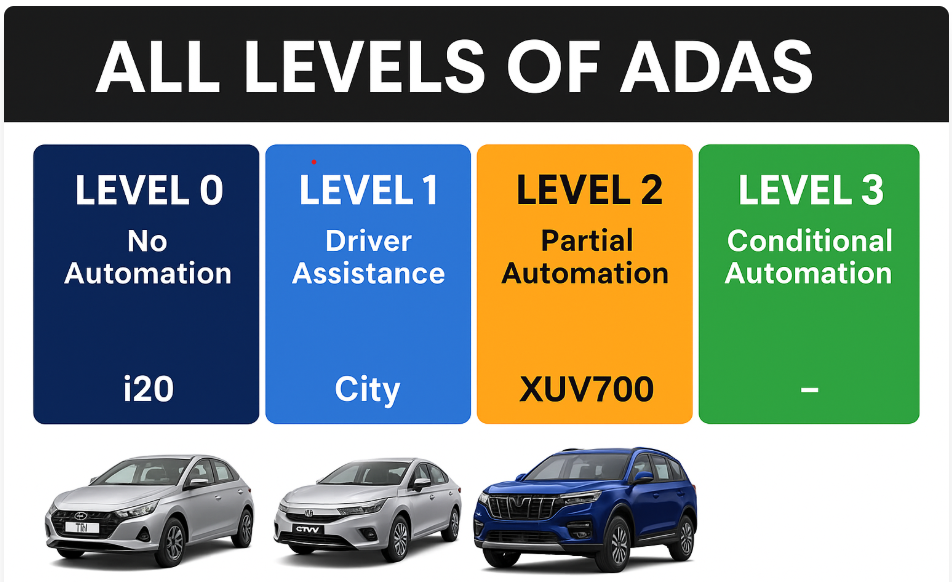Cars are getting smarter. And ADAS, or Advanced Driver Assistance Systems, is the technology that’s making it happen. From warning you before a crash to keeping your car in the right lane, ADAS features are designed to make driving safer and easier.
But did you know that there are 6 different levels of ADAS? Let’s break them down in a simple way and see which Indian cars have what in 2025.
🤔 What is ADAS, really?
ADAS stands for Advanced Driver Assistance Systems – basically, tech inside your car that helps you drive better and safer. These systems assist you – they don’t take full control (yet), but they support you with:
-
Lane keep assist (keeps your car from drifting)
-
Emergency braking (applies brakes to avoid accidents)
-
Adaptive cruise control (maintains distance from the car ahead)
-
Blind spot detection, and more.
Think of ADAS as your co-pilot. It doesn’t replace you – it just helps you drive smarter.
🚗 The 6 Levels of Advanced Driver Assistance System (With Indian Examples)
🟢 Level 0 – No Automation
-
What it means: The car gives you warnings, but doesn’t take any action.
-
Indian examples: Most basic or older cars – like Maruti Alto, Tata Tiago, Renault Kwid.
🟡 Level 1 – Basic Assistance
-
What it means: The car helps with either steering or speed, not both.
-
Example features: Cruise control or lane departure alert.
-
Cars in India:
-
Honda City (non-hybrid)
-
🟠 Level 2 – Partial Automation
-
What it means: The car can control both steering and speed, but the driver must always keep an eye on things.
-
Example features: Lane keeping, automatic emergency braking, adaptive cruise control.
These cars in India have Level 2 ADAS in 2025:
-
✅ Mahindra XUV700
-
✅ Hyundai Verna
-
✅ Honda City Hybrid (e:HEV)
-
✅ Tata Harrier & Safari
-
✅ Kia Seltos (2023 facelift onwards)
- ✅ Hyundai Creta
-
✅ MG Astor
-
✅ BYD Atto 3
-
✅ Hyundai Tucson
These systems work best on highways or well-marked roads.
🔴 Level 3 – Conditional Automation
-
What it means: The car can drive on its own in certain situations (like highways), but the driver must be ready to take control.
-
Indian cars with Level 3? ❌ Not yet.
-
Why? Indian roads are chaotic, with poor lane markings, mixed traffic (rickshaws, cows, bikes), and no clear rules.
⚫ Level 4 & Level 5 – High to Full Automation
-
What it means:
-
Level 4: Fully self-driving in certain areas (like inside a smart city).
-
Level 5: No driver needed – the car drives itself anywhere.
-
-
Indian status: ❌ Not available. Still years away.
🧩 Common ADAS Features in Indian Cars
| Feature | Available in India? | Cars That Have It |
|---|---|---|
| Adaptive Cruise Control | ✅ Yes | XUV700, City e:HEV, Tucson, Verna, Seltos, Creta |
| Lane Keep Assist | ✅ Yes | Verna, Astor, Seltos, Creta |
| Blind Spot Detection | ✅ Yes | Harrier, Safari, Tucson, Seltos, Creta, Verna |
| Emergency Braking | ✅ Yes | XUV700, Astor, Verna, Seltos, Creta |
| Rear Cross Traffic Alert | ✅ Yes | Tucson, Atto 3, Harrier, Safari |
| Traffic Sign Recognition | ✅ Yes | MG Astor, BYD Atto 3, XUV700, MG Gloster |
🏆 Best ADAS Cars in India (2025)
| Car | ADAS Level | Key Features |
|---|---|---|
| Mahindra XUV700 | Level 2 | Lane assist, adaptive cruise, braking |
| Honda City e:HEV | Level 2 | Adaptive cruise, emergency braking |
| Hyundai Verna | Level 2 | Lane centering, warnings, braking |
| Kia Seltos / Hyundai Creta | Level 2 | Smart cruise, blind spot alert |
| MG Astor | Level 2 | 14 ADAS features |
| Tata Harrier/Safari | Level 2 | Rear traffic alert, lane assist |
| BYD Atto 3 | Level 2 | EV with advanced ADAS |
🇮🇳 Why Don’t We Have Level 3 or Higher in India?
-
Roads often don’t have proper lanes.
-
Traffic is too unpredictable (people, animals, bikes everywhere).
-
No legal rules for self-driving cars.
-
Still developing the infrastructure needed.
So for now, Level 2 is the most advanced we’ll see in Indian cars.
Also Read:
💬 FAQs
Q.1: Which Indian car first got ADAS?
A: MG Gloster was among the first. MG Astor brought Level 2 at a more affordable price.
Q.2: Can ADAS work properly in India?
A: Mostly on highways. In cities, it can struggle due to messy roads and mixed traffic.
Q.3: Do you need to pay extra for ADAS?
A: Usually, yes. It’s available in top variants or as an optional package.
Q.4: Is ADAS worth it?
A: Yes, if you drive on highways often – it adds a solid safety layer and reduces fatigue.
✅ Final Words
ADAS is the future of safe driving, and it’s already here in many Indian cars. While we’re still a few years away from self-driving cars, Level 2 ADAS is a great step forward.
If you’re planning to buy a car above ₹15–18 lakh, look for ADAS features – they could literally be life-saving.

